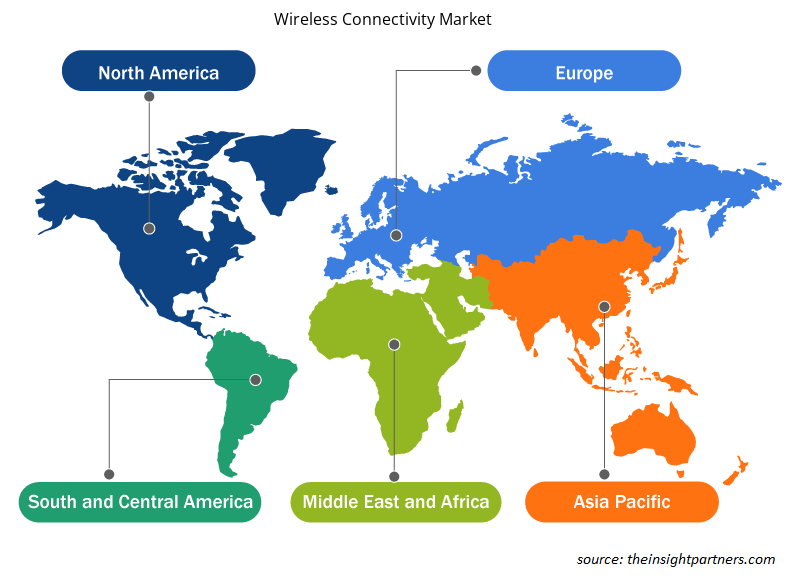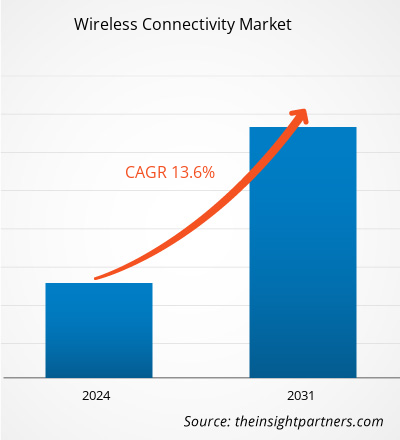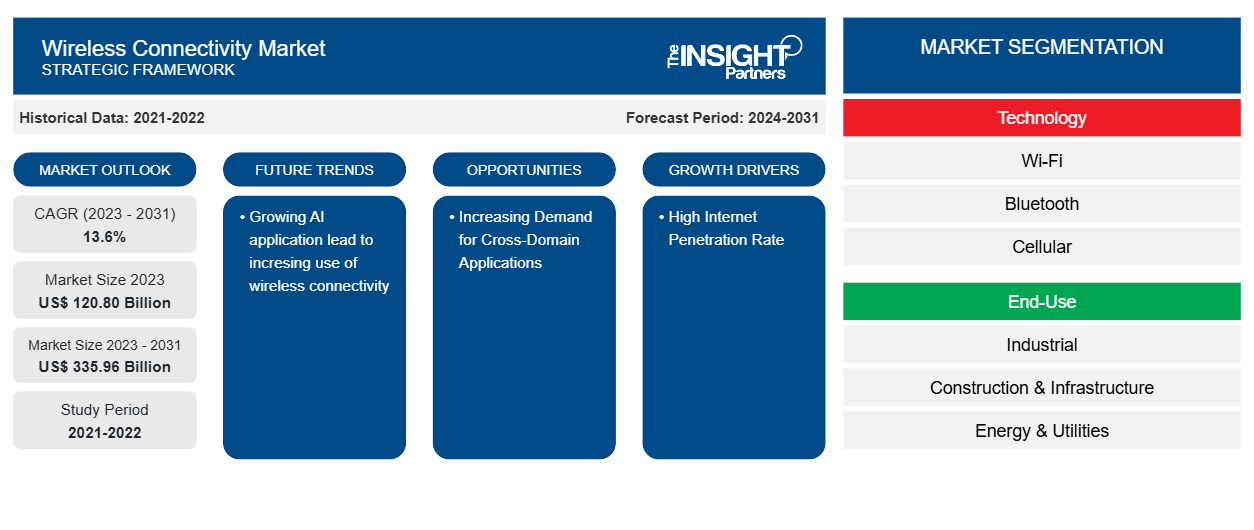Der Markt für drahtlose Konnektivität soll von 120,80 Milliarden US-Dollar im Jahr 2023 auf 335,96 Milliarden US-Dollar im Jahr 2031 anwachsen. Der Markt soll zwischen 2023 und 2031 eine durchschnittliche jährliche Wachstumsrate (CAGR) von 13,6 % verzeichnen. Der globale Markt für drahtlose Konnektivität soll im Prognosezeitraum aufgrund der steigenden Nachfrage nach Cloud-Computing und verwandten Technologien deutlich wachsen.
Marktanalyse für drahtlose Konnektivität
Darüber hinaus ermöglicht die drahtlose Konnektivität den Kunden, Daten mit besonders geringer Latenz zu senden und ihre Autos genau zu finden. Moderne Kommunikationsnetze wie LTE und LTE Advanced können zur Kommunikation mit intelligenten Autos genutzt werden. Intelligentes Fahren wird durch ein verbessertes 5G-Netz und das Internet der Dinge effizient gesteuert. Zahlreiche Fortschritte im Bereich der drahtlosen Kommunikation, darunter die bevorstehende Einführung von Long Term Evolution (LTE), die verstärkte Nutzung intelligenter Geräte, die erhöhte Mobilität und das schnelle Wachstum des mobilen Datenverkehrs, treiben die Nachfrage nach drahtloser Technologie voran . Neuere drahtlose Technologien erfordern mehr Energie und Spektrum. Die beiden am schnellsten wachsenden Mobiltechnologien sind LTE und 5G, und sie werden sich auch in Zukunft weiterentwickeln.
Marktübersicht für drahtlose Konnektivität
Die steigende Nachfrage nach Unterhaltungselektronik wird das Marktwachstum ankurbeln. Darüber hinaus wird erwartet, dass hochentwickelte Technologien wie KI, IoT, AR und VR in einer Vielzahl von Endverbraucherbranchen weiterhin beliebt bleiben. Die globale Entwicklung intelligenter Infrastrukturen ist auch ein wichtiger Treiber der Nachfrage nach drahtlosen Sensornetzwerken.
Infotainmentsysteme können über drahtlose Verbindungen wie WLAN und Bluetooth mit Smartphones und anderen intelligenten Geräten verbunden werden. Infotainmentsysteme können mit den Geräten der Benutzer gekoppelt werden. Sie können den Freisprechmodus nutzen, um während der Fahrt Anrufe anzunehmen, auf Sprachanweisungen zu reagieren und Systeme einfach und bequem zu bedienen.
Passen Sie diesen Bericht Ihren Anforderungen an
Sie erhalten kostenlos individuelle Anpassungen an jedem Bericht, einschließlich Teilen dieses Berichts oder einer Analyse auf Länderebene, eines Excel-Datenpakets sowie tolle Angebote und Rabatte für Start-ups und Universitäten.
-
Holen Sie sich die wichtigsten Markttrends aus diesem Bericht.Dieses KOSTENLOSE Beispiel umfasst eine Datenanalyse von Markttrends bis hin zu Schätzungen und Prognosen.
Treiber und Chancen auf dem Markt für drahtlose Konnektivität
Hohe Internetdurchdringung begünstigt Markt
Die Internetdurchdringung in den entwickelten Ländern Nordamerikas und Europas hat im letzten Jahrzehnt dramatisch zugenommen. Laut Internet World Usage Statistics lebten im Jahr 2022 54,2 % der Internetnutzer in Asien und Europa und 66 % in Nordamerika. Der Nahe Osten und Afrika verzeichnen die höchsten Wachstumsraten bei der Internetnutzung. Die Internetnutzung auf Mobilgeräten nimmt zu. Da der Internetzugang immer wichtiger wird, steigt auch der Bedarf an drahtlosen intelligenten Geräten. In den nächsten fünf Jahren wird sich die weltweite Anzahl der Machine-to-Machine-Verbindungen (M2M) voraussichtlich mehr als verdoppeln. M2M-Verbindungen kommen in Lieferfahrzeugen von Fertigungsanlagen und in Lagerortungssystemen vor.
Steigende Nachfrage nach domänenübergreifenden Anwendungen
Um die drahtlose Technologie voll auszunutzen, sind bereichsübergreifende Fähigkeiten und Zusammenarbeit unerlässlich. Die IoT- und Cloud-Computing-Ökosysteme bieten Organisationen und Unternehmen exponentielle Entwicklungsperspektiven. Organisationen können auf aufkommende Cloud- und IOT-Trends sowie auf technologische Durchbrüche reagieren. Die Leistungsfähigkeit von Organisationen hängt von bereichsübergreifenden Beziehungen und Geschäftsstrategien ab. Huawei Technologies (China) hat LiteOS7 auf den Markt gebracht, ein neues Betriebssystem, das auf verschiedene Segmente wie tragbare Geräte, Smart Homes, das Internet der Fahrzeuge, intelligente Zähler und das industrielle Internet abzielt. Huawei Technologies (China) hat innerhalb des IoT-Ökosystems in mehrere Marktkategorien expandiert. Dies ermöglicht es der Organisation, eine Vielzahl von Anwendungen im IoT anzusprechen.
Marktbericht zur drahtlosen Konnektivität – Segmentierungsanalyse
Schlüsselsegmente, die zur Ableitung der Marktanalyse für drahtlose Konnektivität beigetragen haben, sind Technologie und Endnutzung.
- Basierend auf der Technologie ist der Markt für drahtlose Konnektivität in Wi-Fi, Bluetooth, Mobilfunk, ZigBee, GNSS und andere unterteilt.
- Basierend auf der Endnutzung ist der Markt für drahtlose Konnektivität in die Bereiche Industrie, Bau und Infrastruktur, Energie und Versorgung, Automobil und Transport, Gesundheitswesen, Verbraucher und Sonstige unterteilt.
Marktanteilsanalyse für drahtlose Konnektivität nach Geografie
Der geografische Umfang des Marktberichts zur drahtlosen Konnektivität ist hauptsächlich in fünf Regionen unterteilt: Nordamerika, Asien-Pazifik, Europa, Naher Osten und Afrika sowie Südamerika/Süd- und Mittelamerika. Der asiatisch-pazifische Markt wird voraussichtlich das schnellste Wachstum für drahtlose Konnektivitätssysteme erleben. Beispielsweise schätzt die US-China Economic and Security Review Commission, dass die staatlichen Investitionen in Smart-City-Initiativen in China in diesem Jahr 38,92 Milliarden USD erreichen werden. Das Wachstum der intelligenten Infrastruktur wird wahrscheinlich neue Möglichkeiten für drahtlose Kommunikationssysteme schaffen.
Regionale Einblicke in den Markt für drahtlose Konnektivität
Die regionalen Trends und Faktoren, die den Markt für drahtlose Konnektivität während des Prognosezeitraums beeinflussen, wurden von den Analysten von Insight Partners ausführlich erläutert. In diesem Abschnitt werden auch die Marktsegmente und die Geografie für drahtlose Konnektivität in Nordamerika, Europa, im asiatisch-pazifischen Raum, im Nahen Osten und Afrika sowie in Süd- und Mittelamerika erörtert.

- Erhalten Sie regionale Daten zum Markt für drahtlose Konnektivität
Umfang des Marktberichts zur drahtlosen Konnektivität
| Berichtsattribut | Details |
|---|---|
| Marktgröße im Jahr 2023 | 120,80 Milliarden US-Dollar |
| Marktgröße bis 2031 | 335,96 Milliarden US-Dollar |
| Globale CAGR (2023 - 2031) | 13,6 % |
| Historische Daten | 2021-2022 |
| Prognosezeitraum | 2024–2031 |
| Abgedeckte Segmente |
Nach Technologie
|
| Abgedeckte Regionen und Länder |
Nordamerika
|
| Marktführer und wichtige Unternehmensprofile |
|
Dichte der Marktteilnehmer für drahtlose Konnektivität: Die Auswirkungen auf die Geschäftsdynamik verstehen
Der Markt für drahtlose Konnektivität wächst rasant, angetrieben durch die steigende Nachfrage der Endnutzer aufgrund von Faktoren wie sich entwickelnden Verbraucherpräferenzen, technologischen Fortschritten und einem größeren Bewusstsein für die Vorteile des Produkts. Mit steigender Nachfrage erweitern Unternehmen ihr Angebot, entwickeln Innovationen, um die Bedürfnisse der Verbraucher zu erfüllen, und nutzen neue Trends, was das Marktwachstum weiter ankurbelt.
Die Marktteilnehmerdichte bezieht sich auf die Verteilung der Firmen oder Unternehmen, die in einem bestimmten Markt oder einer bestimmten Branche tätig sind. Sie gibt an, wie viele Wettbewerber (Marktteilnehmer) in einem bestimmten Marktraum im Verhältnis zu seiner Größe oder seinem gesamten Marktwert präsent sind.
Die wichtigsten auf dem Markt für drahtlose Konnektivität tätigen Unternehmen sind:
- Broadcom Inc.
- Cypress Semiconductor Corporation
- Intel Corporation
- Media Tek Inc.
- Microchip Technology GmbH
- NXP Semiconductors NV
Haftungsausschluss : Die oben aufgeführten Unternehmen sind nicht in einer bestimmten Reihenfolge aufgeführt.

- Überblick über die wichtigsten Akteure auf dem Markt für drahtlose Konnektivität
Neuigkeiten und aktuelle Entwicklungen zum Markt für drahtlose Konnektivität
Der Markt für drahtlose Konnektivität wird durch die Erhebung qualitativer und quantitativer Daten nach Primär- und Sekundärforschung bewertet, die wichtige Unternehmensveröffentlichungen, Verbandsdaten und Datenbanken umfasst. Im Folgenden finden Sie eine Liste der Entwicklungen auf dem Markt:
- Im Februar 2022 kündigte Verizon die Erweiterung seines Internetdienstes an, der es Kunden ermöglicht, im ganzen Land, darunter in über 30 Millionen Haushalten und mehr als 2 Millionen Unternehmen, auf zuverlässige, schnelle Plug-and-Play-WLAN-Internetdienste zuzugreifen.
(Quelle: Verizon, Unternehmenswebsite, 2022)
- Im August 2022 kündigte AT&T die Absicht an, seinen Glasfaser-Internetdienst auf Arizona auszuweiten. Die Verfügbarkeit soll 2023 erfolgen. Das Startup versprach, über 100.000 Haushalte in und um Mesa mit glasfaserbasierten Breitbandgeschwindigkeiten von bis zu 5 Gigabit pro Sekunde zu versorgen.
(Quelle: AT&T, Unternehmenswebsite, 2022)
Marktbericht zur drahtlosen Konnektivität – Abdeckung und Ergebnisse
Der Bericht „Marktgröße und Prognose für drahtlose Konnektivität (2021–2031)“ bietet eine detaillierte Analyse des Marktes, die die folgenden Bereiche abdeckt:
- Marktgröße und Prognose auf globaler, regionaler und Länderebene für alle wichtigen Marktsegmente, die im Rahmen des Projekts abgedeckt sind
- Marktdynamik wie Treiber, Beschränkungen und wichtige Chancen
- Wichtige Zukunftstrends
- Detaillierte PEST/Porters Five Forces- und SWOT-Analyse
- Globale und regionale Marktanalyse mit wichtigen Markttrends, wichtigen Akteuren, Vorschriften und aktuellen Marktentwicklungen
- Branchenlandschaft und Wettbewerbsanalyse, einschließlich Marktkonzentration, Heatmap-Analyse, prominenten Akteuren und aktuellen Entwicklungen
- Detaillierte Firmenprofile
- Historische Analyse (2 Jahre), Basisjahr, Prognose (7 Jahre) mit CAGR
- PEST- und SWOT-Analyse
- Marktgröße Wert/Volumen – Global, Regional, Land
- Branchen- und Wettbewerbslandschaft
- Excel-Datensatz
Aktuelle Berichte
Verwandte Berichte
Erfahrungsberichte
Grund zum Kauf
- Fundierte Entscheidungsfindung
- Marktdynamik verstehen
- Wettbewerbsanalyse
- Kundeneinblicke
- Marktprognosen
- Risikominimierung
- Strategische Planung
- Investitionsbegründung
- Identifizierung neuer Märkte
- Verbesserung von Marketingstrategien
- Steigerung der Betriebseffizienz
- Anpassung an regulatorische Trends























 Kostenlose Probe anfordern für - Markt für drahtlose Konnektivität
Kostenlose Probe anfordern für - Markt für drahtlose Konnektivität